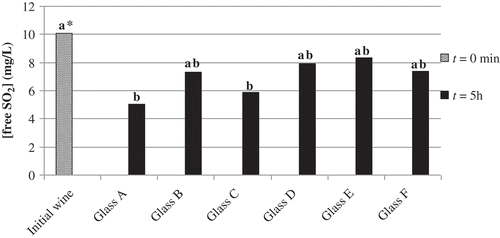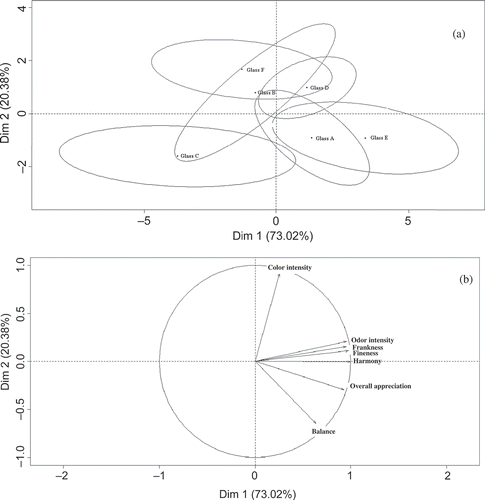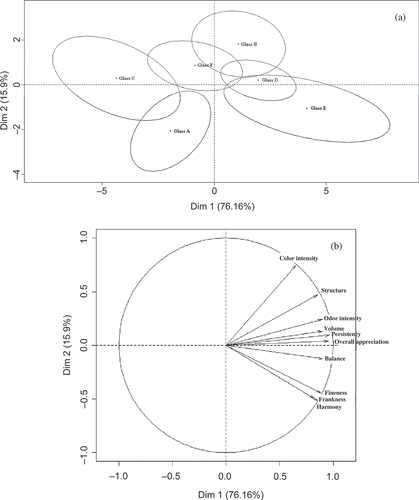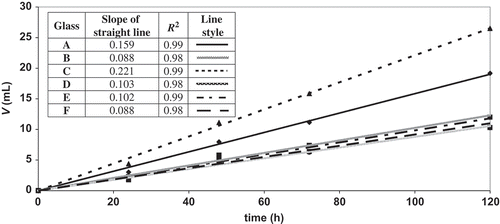Abstract
With the aim to better understand how the differences related to the glass type can influence the consumer perception of the wine, the same product was assessed in each glass, at the same moment, for three times (t = 0, 40 and 120 min) during every tasting session.
The evolution of wine in each glass was characterized also by a chemical and physical point of view, in order to verify if the different characteristics of the glasses utilized influenced the chemical parameters analyzed, so to justify the changes in the sensorial perception expressed by the panel components.
Thanks to the general overlapping between the developments related to the evolution of sensorial, chemical and physical characteristics of the wine, it was possible to define a final classification of the types of glasses utilized and identify which glass seemed to show the best influence on the sensory perceptions of the wine tasted.
Con el fin de comprender mejor cómo las diferencias relacionadas con el tipo de cristal de una copa pueden influir en la percepción del vino por parte del consumidor, se realizaron sesiones de degustación en las que en el mismo momento y en tres ocasiones (t = 0, 40 y 120 minutos), el mismo producto fue catado en diferentes tipos de copa. Las modificaciones experimentadas por el vino en cada una de las copas utilizadas fueron caracterizadas desde el punto de vista físico y químico en cada sesión de degustación. Asimismo, la evolución de vino en cada copa fue caracterizada desde el punto de vista tanto químico como físico, a fin de verificar si las distintas particularidades de las copas utilizadas influyeron en los parámetros químicos del vino, pudiendo justificar los cambios en la percepción sensorial expresada por los integrantes del panel. El traslape general ocurrido durante los eventos relacionados con la modificación de las características sensoriales, químicas y físicas del vino, permitió realizar una clasificación final de los tipos de copas utilizados e identificar aquella copa que parecía tener la mejor influencia en las percepciones sensoriales del vino degustado.
Introduction
In sensorial characterization of wine, the glass represents an essential tool which makes possible the interaction between wine and taster’s senses (Schifferstein, Citation2009; Schifferstein, Fenko, Desmet, Labbe, & Martin, Citation2013). Since the choice for a particular type of vessel could affect consumer perception during wine consumption, in the last years some researchers investigated the effect of varying the material, color and shape of the glass on the perceived aroma, taste and flavor of wine (Cliff, Citation2001; Delwiche & Pelchat, Citation2002; Hirson, Heymann, & Ebeler, Citation2012; Hummel, Delwiche, Schmidt, & Hüttenbrink, Citation2003; Russell, Weiss, Zivanovic, & Morris, Citation2002; Venturi et al., Citation2009). According to the more traditional physical/chemical interpretation, different glass shapes release different amount of volatile organic compounds from the wine’s surface (Spence, Harrar, & Piqueras-Fiszman, Citation2012). Moreover, the type of glass can influence both the development of some chemical and physical processes occurring (i.e. chemical oxidations and evaporation) (Jackson, Citation2009; Liger-Belair, Polidoric, & Zéninaria, Citation2012; Vilanova & Vidal, Citation2008) and the headspace volatile composition and the aroma profile of the wine (Hirson et al., Citation2012).
Despite the significant effect of the glass shape on the sensorial expression of the wine, the existence of some correlations between types of glass and aroma sensory descriptors of intensity and quality has not yet clearly put in evidence (Hirson et al., Citation2012).
Since the choice of the best combination of “glass type” and “wine tasted” appears to be an important factor for the definition of the wine sensorial profile (Billing, Öström, & Lagerbielke, Citation2008; Cliff, Citation2001), an experimental research was developed to investigate the impact of glass shape on the sensory perception of the attributes of a full-bodied red wine obtained from “Sangiovese” grapes and aged in oak barrels.
The sensorial profiles, obtained for the wine tasted as a function of the geometric characteristics of six commercial different glasses (Glass Code: A÷F), were compared to each other. In order to find any significant parameters useful to represent the time evolution of the wine as a function of the different glasses, the wine poured in all the glasses was characterized also by a chemical/physical point of view, at different equilibration times.
Materials and methods
Wine and glasses
A full-bodied red wine (Castello di Ama, DOCG) aged in oak barrels and obtained utilizing Sangiovese grapes, harvested in Chianti Classico region (Italy), was utilized. Six different wine glasses (), supplied by “Bormioli Rocco e figlio” (Parma, Italy), were used during the tasting sessions. Among all the glasses utilized, the Glass F was adopted as “reference glass” because of its similarity with the “official-tasting glass” (ISO).
Table 1. Glasses utilized for the experimental runs.
Tabla 1. Copas usadas durante las pruebas de ensayo.
The glass capacity was determined measuring the mass of water contained inside (18ºC). Glass shape parameters were measured either by a calipers or by measuring circumference (Hirson et al., Citation2012). Glasses were filled always with the same volume of wine (120 mL), to avoid the influence of this variable on the wine evolution.
Chemical–physical characterization of wine
Chemical evolution
In order to better understand the time evolution of the wine used as a function of each glass utilized, some chemical characteristics of the product (titratable acidity, volatile acidity, free SO2, total phenols, total and free anthocyanins, proanthocyanins) were determined, according to AOAC methods (AOAC, Citation2000). Each determination was repeated in duplicate. Because of the chemical analysis shows a sensitivity much lower than sensorial analysis, even if it is more objective than the other, to obtain any reliable variations in chemical composition it had been necessary to collect the last sample of wine after 5 h of filling, in static conditions at room-controlled temperature and constant RH (T = 18°C, relative humidity (RH) = 80%).
Evaporation rate
Because of the importance of smell intensity in the definition of overall quality of a wine, the evaporation rate of the wine maintained in the different glasses was also determined with the aim to find a physical parameter that could be able to represent the loss of smell intensity of the wine as a function of the glass shape. To describe accurately the evolution of evaporation process, it was necessary to collect experimental data until 120 h of waiting and such measurements have to be considered as a rough measure of what happened at 120 min.
The evaporation rate was measured by determining the losses of weight of the wine inside each glass at different times. The time evolution of evaporation processes was represented by some straight lines passing through the origin of cartesian axis.
Sensorial analysis
Sensorial characterization of wine
The sensorial profiles of the wine, as a function of the glass utilized for tasting, were carried on by a trained panel (10 assessors, 7 males and 3 females, aged 30–65 years) who used a sensorial sheet, specifically developed for this purpose (), consisting of a non-structured parametric descriptive wine scoring chart. Tasting was carried out in the morning, in a well-ventilated quiet room and in a relaxed atmosphere. The timing of the tasting sessions was fixed at 120 min after the filling of the glasses, with three different assessments (at t = 0, 40 and 120 min after filling the glasses) and the wine was assessed at the same time in all the glasses utilized.
Table 2. First-order descriptors utilized to define the non-structured parametric descriptive scoring chart.
Tabla 2. Descriptores de primer orden utilizados para definir la tabla de clasificación paramétrica, descriptiva y no estructurada.
The participants ranked the wine contained in each glass on a scale of 0–10; they commented regarding the qualities and evaluated the intensity of each parameter to include visual, aroma and taste attributes, as well as an hedonic parameter such as the overall impression (Martin & Rasmussen, Citation2011).
By utilizing the proposed sheet, it was possible to obtain a sensory profile of the analyzed wine on the basis of the first-order descriptors of color, flavoring and taste and of the hedonic parameter related to the overall appreciation.
All the assessments were repeated in double in two different sessions by the same group of panelists. The reliability of the judgments obtained was evaluated by statistical analysis ( two-way ANOVA Cohort 6;PCA, program R, version 2.10.0).
Results and discussion
Chemical and physical characterization of wine
Chemical evolution of wine
Among the data collected (), the more suitable to follow the chemical evolution of the wine seems to be the free fraction of SO2 that represents the most sensible antioxidant compound present inside the wine used. As shown in , Glass E, closely followed by Glass D, allows to preserve the greatest fraction of free SO2, while the wine maintained in Glass A shows the lowest amount of this compound after 5 h of waiting. As well as the different evaporation rate, also the different decreases in SO2 concentration seem to show that the wine interacts with atmospheric oxygen in a different way as a function of the glass in which it is contained and this could affect its sensory properties.
Figure 1. Concentration of free SO2 in the initial wine and after 5 h of waiting after filling the glasses.
Figura 1.Concentración de SO2 libre en el vino inicial y después de 5 horas de espera tras llenar las copas.

Table 3. Chemical composition of wine at different equilibration time (t = 0 min, t = 5 h after filling the glasses).
Tabla 3. Composición química del vino en distintos tiempos de equilibrio (t = 0 minutos, t = 5 horas tras llenar las copas).
Evaporation rates
As showed in , it can be observed that a significant difference among the glasses, regarding the amounts of wine evaporated at different run times, exists. In fact, the rate of evaporation was the highest for the Glass C, followed by that observed when Glass A was used. Moreover the couples of Glasses D/E and B/F are respectively characterized by analogous decreases of the weight of the wine contained inside the glass. The development of decrease of weight of glass content as a function of run time can be represented by means of straight lines, passing through the origin, one for each glass and the related slopes can be assumed as a measure of the evaporation rate (). The suitability of the approach followed in the statistical elaboration of these experimental results appears to be tested by the high values of the squares of correlation coefficients (R2) obtained ().
Sensorial characterization of wine
Sensorial analysis
To verify if and how the sensory properties of wine changed qualitatively and quantitatively over time of tasting (Hirson et al., Citation2012), analysis of variance was performed on the experimental data related to the sensory attributes, at different tasting times (t = 0, 40 and 120 min after filling the glasses). In are reported the results of ANOVA applied to the attributes related to the intensity and quality of the main attributes utilized to describe view, smell and taste, as well as the overall appreciation. Two-way ANOVA with glass and panelist as main effects indicated that the differences among the wine contained in different glasses increase with tasting time. In particular, Glasses E and C have significantly different mean intensities within each descriptor, except the color intensity, for a tasting of 120 min, but while the first one shows always the best value (a), the other vessel seems to be always characterized by the worst (c or d). In particular, the overall appreciation seems to be the best descriptor able to discriminate the wine contained in different types of glass and the Glass E was the most preferred by the panelists to appreciate the characteristics of well-structured red wine at each tasting time.
Table 4. Sensorial evolution of wine at different equilibration time (t = 0, 40 and 120 min after filling the glasses).
Tabla 4. Evolución sensorial del vino en distintos tiempos de equilibrio (t = 0, 40 y 120 minutos tras llenar las copas).
Moreover, principal component analysis (PCA) of each sensory attribute across six different types of glass was performed to illustrate graphically the correlations between ratings given to the different descriptors at the start and at the end of tasting sessions (t = 0 min; t = 120 min; (a) and (b); (a) and (b)). In the PCA, all attributes were taken so it was possible to have a complete picture of the sensory evaluations results. At both times, the first two principal components explained a percentage of the total variance greater than 90% (93.40% and 92.06%, respectively). In both the assessing sessions analyzed (t = 0 and t = 120 min), the first principal component (PC1) was positively characterized by the overall appreciation, odor intensity, taste persistency, color intensity, odor harmony, frankness, equilibrium of taste attributes, having positive loadings. For the second principal component (PC2), the attributes color intensity, odor intensity showed positive loadings, while equilibrium of taste was loading negatively. The correlations circles ( for t = 0 min and for t = 120 min) show the weights of the sensory attributes for each component.
Figure 3. Sensorial profile of wine (PCA) as a function of the different glasses (t = time of filling the glasses): (a) confidence ellipses by a mean points; (b) variables factor map.
Figura 3.Perfil sensorial del vino (PCA) en función de las distintas copas (t = tiempo después de llenar las copas): (a) elipses de confianza por puntos medios; (b) mapa de factores variables.

Figure 4. Sensorial profile of wine (PCA) as a function of the different glasses (t = 120 min after filling the glasses): (a) confidence ellipses by a mean points; (b) variables factor map.
Figura 4.Perfil sensorial del vino (PCA) en función de las distintas copas (t = 120 minutos tras llenar las copas): (a) elipses de confianza por puntos medios; (b) mapa de factores variables.

At the starting time of the tasting session (), soon after the pouring, sensorial analysis results indicate the existence of some sensory differences according to glasses, when their geometrical characteristics are significantly different. In particular, the wine contained in the Glass C is characterized by a sensorial expression significantly worst, with reduced color and odor intensity and overall appreciation, than those obtained using Glasses A, F, D and E. Moreover the sensory expression of the wine poured in the Glass E greatly differs from those related to the Glasses B, F and C and shows the best performance in term of overall appreciation also at the start of equilibration time. More similar seem to be the sensory results of the Glasses F and D and those exhibited by the couples of Glasses A and E.
After 120 min of waiting, the results of sensory determinations change greatly as a function of the different glasses utilized during the panel test (Figure (a) and (b)). The mean points of the confidence ellipses related to the glasses increased their distance one from another. At this time (120 min), the best sensorial profile was showed by the wine maintained in Glass E, closely followed by that in Glass D. The variables of the factor map remained nearly the same even if there was the addition of a few others related to the taste (structure, volume and persistency), probably because of the effect due to the interaction between the oxygen dissolved in the liquid phase and the wine during the time of waiting, that allowed the evolution of this well-structured red wine.
Conclusions
The results obtained show how the characteristics of a glass could affect wine’s bouquet and flavor and suggest that their rational optimization, based on experimental data, could enhance consumer enjoyment of wines.
With the aim to obtain a synthesis of the data collected at very different equilibration times after filling the glasses during the sensorial (2 h), chemical (5 h) and physical (120 h) characterization of the wine, the results obtained have been utilized in order to attribute to each glass a score related to the values assumed by the experimental parameters which showed reliable differences in sensory, chemical and physical evaluations. The final ranking, obtained for each glass by the sum of each score assigned, could be utilized to draft a list of preference among the vessels examined for the type of wine tasted () and the more objective and reliable glass profiles obtained could be useful both for wine industries than for glass producers: in particular Glass E was individuated as the best glass for tasting a full-bodied red wine. In particular, the ranking of sensorial profile was carried out according to the parameter of “overall appreciation”, while the chemical evolution was ranked according to the concentration of “free SO2”.
Because the values of the parameters were determined at different run times, it has been possible to understand their time evolutions and to recognize the more suitable glass to characterize a certain style of wine (in this case a full-bodied red wine) among those which had been investigated. As future trend of this research, the data collected could be validated by applying the same experimental framework to different full-bodied red wines.
Table 5. Final ranking of glasses for their utilization for tasting a full-bodied red wine.
Tabla 5. Ranking final de copas para utilizarse en la degustación de vino tinto con cuerpo.
On the basis of experimental data obtained, a new “integrated approach”, deriving from the merging of the chemical, physical and sensorial data, is proposed with the aim to define the main characteristics of a wine that can be used to design (or to select among those already existing) the optimum vessel for increase in the enjoyment of the consumer during the wine assessing.
Acknowledgment
This research project was made possible by funding from “Bormioli Rocco e figlio” SpA, Parma, Italy.
References
- AOAC International (Association of Official Analytical Chemists). (2000). In W. Horwitz (Ed.), Official methods of analysis of AOAC International (17th edn, vol. II). MA, USA.
- Billing, M., Öström, Å., & Lagerbielke, E. (2008). The importance of wine glasses for enhancing the meal experience from the perspectives of craft, design and science. Journal of Food Service, 19(1), 69–73.
- Cliff, M. A. (2001). Impact of wine glass shape on intensity of perception of color and aroma in wines. Journal of Wine Research, 12, 39–46.
- Delwiche, J. F., & Pelchat, M. L. (2002). Influence of glass shape on wine aroma. Journal of Sensory Studies, 17, 19–28.
- Hirson, G. D., Heymann, H., & Ebeler, S. E. (2012). Equilibration time and glass shape effects on chemical and sensory properties of wine. American Journal of Enology and Viticulture, 63, 515–521.
- Hummel, T., Delwiche, J. F., Schmidt, C., & Hüttenbrink, K.-B. (2003). Effects of the form of glasses on the perception of wine flavors: A study in untrained subjects. Appetite, 41, 197–202.
- Jackson, R. (2009) Wine tasting. A professional handbook (2th ed.). London: Elsevier Academic Press.
- Liger-Belair, G., Polidoric, G., & Zéninaria, V. (2012). Unraveling the evolving nature of gaseous and dissolved carbon dioxide in champagne wines: A state-of-the-art review, from the bottle to the tasting glass. Analytical Chimica Acta, 732, 1–15.
- Martin, K. R., & Rasmussen, K. K. (2011). Comparison of sensory qualities of geographically paired organic and conventional red wines from the Southwestern US with differing total polyphenol concentrations: A randomized pilot study. Food and Nutrition Sciences, 2, 1150–1159.
- R VERSION 2.10.0 COPYRIGHT (C), 26 October 2009. The R foundation for statistical computing, ISBN 3-900051-07-0 (2009).
- Russell, K., Weiss, J., Zivanovic, S., & Morris, W. (2002, 15–19 June). Effect of glass shape and storage temperature on the concentration of polyphenolic compounds in Merlot. Paper presented at Institute of Food Technologists Annual Meeting, Anaheim, CA. Abstract 61B–28.
- Schifferstein, H. N. J. (2009). The drinking experience: Cup or content? Food Quality and Preference, 20, 268–276.
- Schifferstein, H. N. J., Fenko, A., Desmet, P. M. A., Labbe, D., & Martin, N. (2013). Influence of package design on the dynamics of multisensory and emotional food experience. Food Quality and Preference, 27, 18–25.
- Spence, C., Harrar, V., & Piqueras-Fiszman, B. (2012). Assessing the impact of the tableware and other contextual variables on multisensory flavour perception. Flavour, 1, 7. doi:10.1186/2044-7248-1-7
- Venturi, F., Zinnai, A., Andrich, G., Andreotti, A., Ferroni, G., & Scalabrelli, G. (2009) The effect of glass type on sensorial perception of dessert wines made from Malvasia grapes. Paper presented at III International Simposium on the Malvasie, Canarie (Spain), 26–30 May.
- Vilanova, M., & Vidal, P. (2008). Effect of the glass shape on flavor perception of “toasted wine” from Ribeiro. Journal of Sensory Studies, 23, 114–124.

